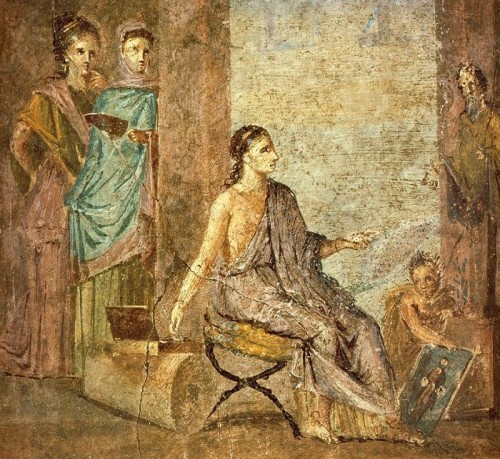 |
| Woman artist painting statue of Priapus Fresco from the Casa del Chirurgo |
My intention for this blog is to document the lives and works of these women, share their stories, and show their art. Because I like things that are liner and orderly, and because I like to know how things begin,I'm beginning with a few of the earliest artists: Kora, Thamar and Ende. Technically these women are pre-Middle Ages and Rennaissance, but are, I believe critical to the story of women in art.
Kora (or Callirhoe) was born in Sicyon (ancient Greece) around 650 BCE. IT is said that Kora was very beautiful and had many suitors. She apparently favored one above the others because she drew a charcoal portrait of him on the wall. Her father, Dibutades of Sicyon, a respected potter and sculpture, took the drawing and from it created the first relief. Little else is known about Kora as an artist; she did go on to marry the young man that she drew the picture of. She is mentioned by Pliny the Elder in his Natural History.
Thamar, also known as Tamar and Thamyris and Timarete, was once thought to be a myth. In fact, she was a real person, a Greek painter who lived in the 5th century B.C. Thamar was the daughter of Micon the Younger of Athens, a well-known and respected painter. Less interested in the running of a household and more interested in painting, Thamar apparently began working alongside her father. She too is mentioned by Pliny. Of Thamar Pliny says, "she scorned the duties of women and practiced her father's art." She was best known in Pliny's time for a panel painting of the Goddess Diana (Artemis) which was displayed in the Goddess's temple at Epheseus. Unfortunately, the temple, along with Thamar's work, was destroyed in either a Goth invasion in the Third Century or by an anti-pagan mob led by Saint John Chrysostom in the 400s A.D. (Historians disagree on who gets the credit for the destruction.) Sadly, none of her work remains, so we are left to appreciate her effort through the words of Pliney.
Ende, is believed to be a Spanish nun that was a manuscript illuminator in the 10th-century. She was a collaborator on a set of manuscripts, which contain the Commentary on the Apocalypse compiled by the Spanish monk Beatus of Liébana in 786. Her signature appears in the Beatus located now at the Girona cathedral, known as Girona Beatus but maybe she worked in some other codex.
Ende, is believed to be a Spanish nun that was a manuscript illuminator in the 10th-century. She was a collaborator on a set of manuscripts, which contain the Commentary on the Apocalypse compiled by the Spanish monk Beatus of Liébana in 786. Her signature appears in the Beatus located now at the Girona cathedral, known as Girona Beatus but maybe she worked in some other codex.
The Last Judgment, painted by Ende, from the Gerona Beatus
|
The manuscripts were created in a monastery in the mountains of Leon in northwest Spain. There are a number of hands discernible in the manuscripts. The chief painter was likely a priest called Senior. Historians have also attributed elements of the manuscripts to Emetrius, whose style is attributable in comparison to an earlier signed work. The third attributable hand is that of Ende. She signed the work as DEPINTRIX (painter) and DIE AIUTRIX (helper of god). It is thought that Ende may be the first european artist that is recorded by history.
Frank, Priscilla. These Are The Revolutionary Women Artists Of The 15th Through 19th Centuries http://www.huffingtonpost.com/2015/03/23/women-artists-_n_6904390.html
Gonzalez, Sandra. Ende: The woman who illustrated the Apocalypse. https://mujeresartistasfemaleartists.wordpress.com/2016/10/18/ende-the-woman-who-illustrated-the-apocalypse-english/
No comments:
Post a Comment